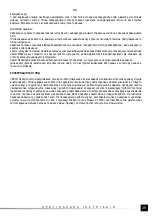
14
GB
O R I G I N A L I N S T R U C T I O N S
protective gloves. Fix the object to be cut to the work station, using clamps or an anvil, etc. Do not ever keep the material being cut
in your hands or other parts of the body. In case of cutting, support the material at its edges and close to the cutting line. Place the
supports at both sides of the cutting line, so that during cutting the blade is not seized in the kerf. During cutting the base must be
placed with the whole surface against the material being cut. Connect the dust extraction system to the connection point.
Turning the jig saw on and off
Make sure the surface at the place of work is even, stable and free from dirt.
Adopt a secure and stable position.
Hold the tool by the handle. Do not support the tool on any object.
Using a finger, move the switch forward and hold it. Make sure the blade moves freely and the tool does not vibrate excessively
and does not emit smoke or a suspicious smell. In case and irregularity is observed, turn the jigsaw off, disconnect the plug from
the mains and have the tool repaired at an authorised service point.
The switch is equipped with a lock, which may be used during long cutting. When the switch is displaced press its frontal part to the
body, and the catch below the switch will lock it in the position. The lock is released when the switch is pushed down at the back.
The tool is turned off when it is unlocked and the switch is released. Once the tool has been turned off, the blade keeps moving
for a while.
Cutting along a straight line
Before cutting may start, it is recommended to mark the cutting on the surface of the material, using for example a pencil. Make
sure the material being cut does not contain any elements of a different hardness grade. For example the wood which to be cut
must not contain nails, stitches or other metal elements. Also avoid electric conductors which may be hidden in the material to
be cut.
Place the base of the tool on the material to be cut, so that the blade does not touch it.
Turn he tool on and wait until it has reached the full velocity that has been set.
Start cutting, guiding the jigsaw with both hands. During cutting, press the jigsaw to the surface and smoothly guide it along the
cutting line. The pressure against the material must not exceed the pressure which is sufficient to realise the task. Avoid inclining
the jigsaw, hitting the blade against the material being cut and changing the direction of cutting. Otherwise, the blade may get
seized in the material, the blade or the material may be damaged (broken), as well as the jigsaw itself.
During cutting of hard metals, e.g. steel, it is required to interrupt the task frequently, in order to cool the blade.
Cutting along curves
Follow all the indications as in case of cutting along a straight line, but use blades designed for cutting curves. Their edge is nar-
rower than in the case of blades designed for straight cutting, which makes cutting curves easier.
In case of cutting orifices, it is recommended to mark the shape of the orifice to be cut, and then drill a hole in its edge whose
diameter exceeds the width of the blade. The wall of the drilled orifice should be aligned with the line of the orifice to be cut. Insert
the blade of the jigsaw into the orifice and start cutting.
Additional remarks
Avoid overloading the tool – the temperature of the external surfaces must not exceed 60oC.
Once the task has been concluded, turn the jig saw off, remove the plug of the tool from the mains socket and inspect the ma-
chine.
The declared total value of vibration has been determined by means of a standard measurement method and may be used to
compare the tool with another one. The declared total value of vibration may be used for an initial evaluation of exposure.
Attention! The vibration caused during work with the tool may differ from the declared value, depending on the way in which the
tool is used.
Attention! It is required to determine safety measures to protect the operator, based on evaluation of exposure under actual
circumstances of operation of the machine (including all the phases of the working cycle, for example the time when the tool is off
or is idling, and the activation time.
MAINTENANCE AND OVERHAUL
ATTENTION! Before any adjustment, technical service or maintenance operations unplug the tool. Once the operations have been
finished, the technical conditions of the tool must be assessed by means of external evaluation and inspection of the following
elements: body and handle, conductor with a plug and deflection, functioning of the electric switch, patency of ventilation slots,
sparking of brushes, noise level of functioning of bearings and gears, start-up and smoothness of operation. During the guarantee
period, the user cannot dismantle the electric tools or change any sub-assemblies or elements, since it will cancel any guarantee
rights. All irregularities detected at overhaul or during functioning of the tools are a signal to have the tool repaired at a service
shop. Once the functioning has been concluded, the casing, ventilation slots, switches, additional handle and protections must be
cleansed with a stream of air (at a pressure not exceeding 0.3 MPa), with a brush or a cloth without any chemical substances or
cleaning liquids. Tools and handles must be cleansed with a clean cloth.















































